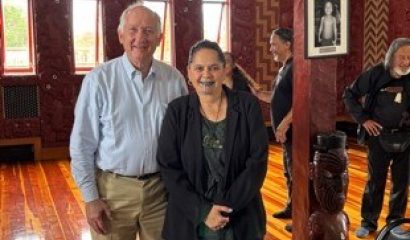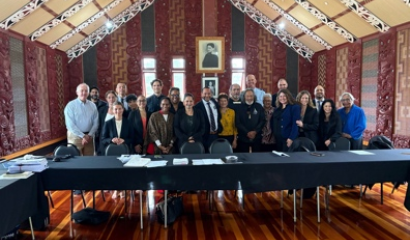In March I had the opportunity to travel to New Zealand with a delegation of youth justice system leaders from California courts, foundations, and nongovernmental agencies to study the New Zealand youth justice system. Since 1989, New Zealand has received worldwide acclaim for its approach to justice-involved youth. New Zealand prioritizes strong communities and families as integral support systems for youth. The approach emphasizes healing and restoration . Community and family connections are central to the approach which is strongly rooted in Pacific Islander cultural traditions. This is significant because the vast majority of system-involved youth are Māori.
New Zealand’s juvenile justice process is similar to that of the US, with some important differences. The prosecution is conducted by the police who determine the charges and appear in court. Unlike in the US, if a case proceeds, the central component, prior to adjudication, is a Family Conference (FC). The FC includes the police agency and state social services representative (which appears to be our probation equivalent). Unlike in the US, the FC participants also include the youth, family members, defense attorney, and victims. The process is built on a consensus model that requires agreement from all participants. Through this process, a proposed intervention strategy is devised with a case plan that must be agreed upon by the youth and family. If a consensus is not achieved, the case will proceed to the judge who makes the final decision to either implement the plan or send it back to the social worker for revisions. In this process, the defense is present at all stages and is included in the planning. This is unlike California and traditional American juvenile justice practice, where the probation department develops a disposition case plan recommendation and presents it to the judge.1Historically, in the U.S., probation departments are solely responsible for the development and implementation of the disposition case plan. In recent years, disposition reports developed by probation departments have been challenged by defense attorneys, aided by in-house social workers and community agencies that present counter recommendations at disposition hearings. These hearings are conducted as part of the adversarial court process in which youth are often subject to highly inflammatory and degrading comments about their families and character. These comments and proceedings often leave emotional scars that damage a youth’s fragile self-image and contribute to long term resentment towards the justice system and authority figures. Furthermore, the demeaning nature of the process can result in long term damage to family relations and further inhibit healthy development.
New Zealand has made significant strides in mitigating the damaging effects of the justice system by developing strategies and structural changes that emphasize familial and community relationships. By drawing on Polynesian cultural traditions that emphasize family and community ties, New Zealand has pioneered a new approach that is applicable to California. The use of the FC offers the potential for radically altering one of the most dysfunctional and damaging elements of the American juvenile justice system :the absence of a unified planning approach that includes the youth advocates, community resources, and family members as equal partners in the process. The NZ system is built on consensus, requiring everyone’s buy-in before the case goes to the judge. If there is disagreement and a consensus cannot be formed the judge can refer the case back or render a final decision.
The benefits of the NZ process ensures that recommendations on the youth’s fate are not solely decided by one individual probation officer or agent of the court — such as in the United States. The traditional reliance on the probation officer in California typically excludes the meaningful input of the youth, family, and attorney. The New Zealand system places its emphasis on building stronger and more resilient families through a unified approach.2An agency exercising sole control over the decision-making process leads to the routinization of treatment decisions over time regardless of well-intended policies. Treatment routinization and calcified decision making easily occurs even within a consensus model when one participant holds disproportionate power and other participants are compelled to reach agreement that conforms to the dominant party. The NZ model appears to recognize this reality and attempts to mitigate the dominance of state agencies through a family centered model that requires youth and family participation.
The other benefit of this approach is the lesser emphasis on mental health diagnoses and professionalized care. While not rejecting the need for mental health treatment, our hosts expressed caution and concern about the labeling that results from mental health diagnoses. Professional mental health services seemed to be reserved for youth with more severe and obvious needs. One critique of the JJ system in California is the emphasis on mental health and professionalized intervention that is often driven by funding streams.3
One of the most important lessons from NZ is their rejection of congregate institutional and group home care as a primary intervention for youth offenders. In instances in which youth are placed out of the home, the preference is for extended family placement. In one instance, we were informed that out of 23 family placement, 12 successfully graduated, 7 were progressing, and only 4 needed additional placement. These statistics are strong evidence for arguments favoring family placement and the sustainability of familial relationships. In another instance in Judge Cassidy’s court, we observed a hearing involving a 17- year-old male who was accompanied by his aunt and mother. He resided with his aunt, who was his primary caregiver while his mother resided elsewhere. His aunt did most of the talking when asked by the court about her nephew’s progress. The mother was present and was involved in the treatment process but had assumed a secondary role relative to her sister in her son’s care. While the issues with the mother were not identified at the hearing, the aunt had clearly stepped into the role of primary caregiver and had succeeded in this role. The youth completed his treatment and was released from custody at the hearing.
The family resource group could be adopted within the California juvenile Justice system, but determined and sustained leadership among the key elements within the system such as probation chiefs, judges, attorneys, prosecutors, youth/family and community resources is required. Resistance will come from line staff — such as probation — who would need to relinquish long held authority. Defense attorneys would need to participate in a consensus driven model that would reduce their courtroom advocacy emphasis. Prosecutors would have to relinquish the drive to achieve convictions and be more oriented towards the group and rehabilitation processes.
Possible next steps for building a family conference and unified case planning approach: Possible next steps for building a family conference and unified case planning approach: I think the number one next step needs to be to support families with resources that address their root problems: money, housing, nutrition, education, treatment of whatever health issues they have. This seemed to be the focus of all the stakeholders in the NZ process.
- Convene planning meetings with stakeholders and facilitated by a neutral party – such as a foundation.
- Draft an implementation plan with full consent of all parties
- Identify and assign participating county staff and agencies
- Initiate a pilot with challenging cases to demonstrate its broader potential
- Full implementation
A potential model was established in San Francisco 2007 as a Second Chance reentry demonstration program funded by the US Dept of Justice. The program was initiated by the SF Public Defender’s Office and included the courts, probation, district attorney, and community-based agencies. The program was cited as a national model for collective case planning and was later incorporated by the Juvenile Probation Department as the Juvenile Collaborative Reentry Unit.
I am extremely grateful for having the opportunity to tour the NZ juvenile justice system and to be able to spend time with such a wonderful group of people. Thank you to the sponsors and organizers and all my colleagues for your contributions to improving the lives of California youths.
Sincerely yours,
Daniel Macallair

